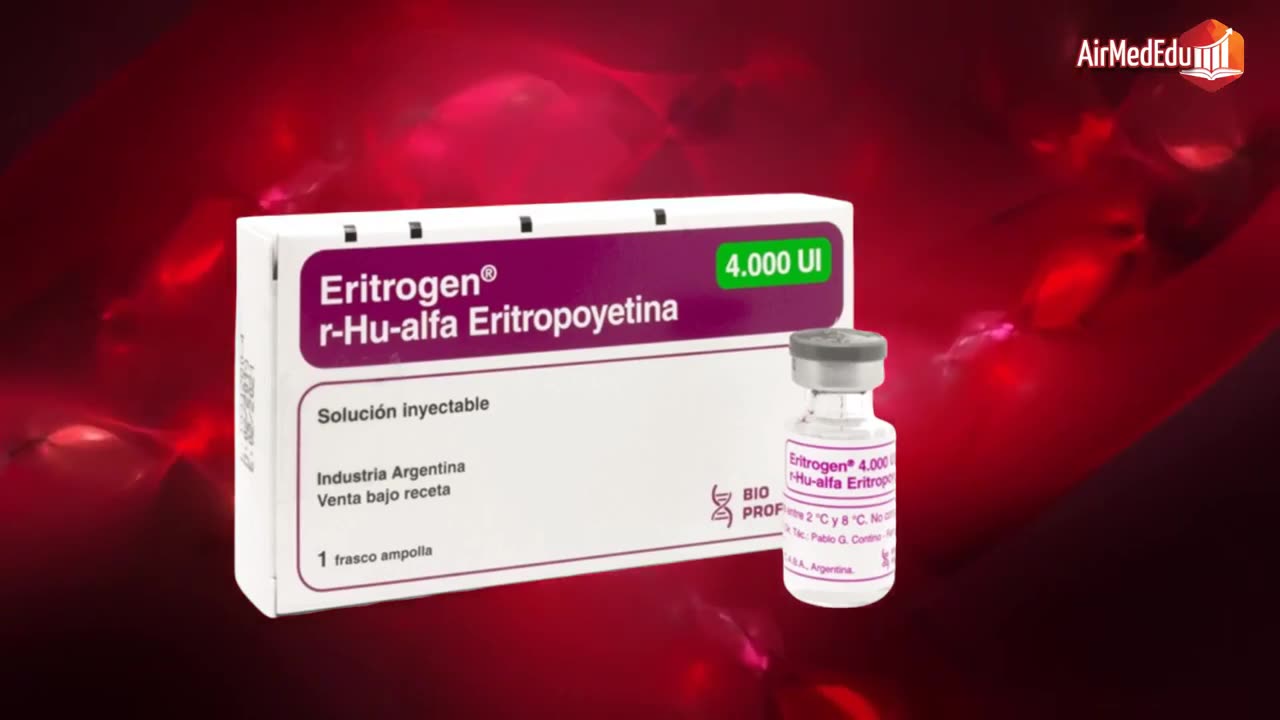Premium Only Content

Erythropoietin, Recommended Dosage
Erythropoietin, commonly known as erythropoietin, is a fascinating hormone that plays a crucial role in regulating red blood cell production in our bodies. Imagine for a moment how the human body, through its complex internal machinery, responds to a lack of oxygen: when oxygen levels drop, the kidneys detect this signal and release erythropoietin, which travels through the blood to the bone marrow, where it stimulates the creation of red blood cells, those vital oxygen carriers. This hormone was discovered in the 1950s, but it wasn't until the 1980s that advances in biotechnology made it possible to produce it recombinantly, that is, through genetic engineering, opening the door to its therapeutic use. Today, recombinant human erythropoietin, such as alpha erythropoietin, has become a mainstay for treating various forms of anemia, helping millions of patients improve their quality of life by reducing the need for blood transfusions.
Erythropoietin's journey from scientific discovery to essential medicine begins with its structure: a 165-amino acid glycoprotein, naturally produced in the kidneys and, to a lesser extent, in the liver. When the body faces conditions such as high altitude or diseases that reduce oxygen, erythropoietin acts as a messenger, promoting the differentiation of precursor cells into mature red blood cells. In the medical field, its synthetic version is administered by injection, either intravenously or subcutaneously, and is available in vials with varying doses, from 2,000 to 40,000 international units per milliliter. But it's not just a tool for athletes seeking to improve their performance illegally; its true value lies in the treatment of anemias associated with chronic diseases, where natural erythropoietin production fails or is insufficient.
One of the most common uses of erythropoietin is in patients with chronic kidney disease, a condition that affects millions of people worldwide and often leads to anemia because the damaged kidneys don't produce enough erythropoietin. In these cases, treatment aims to raise hemoglobin levels to relieve symptoms such as extreme fatigue, weakness, and shortness of breath.
For adults on dialysis, the recommended starting dose is usually 50 to 100 units per kilogram of body weight, administered three times a week, preferably intravenously during hemodialysis sessions, as this facilitates integration with the procedure. This approach allows for precise monitoring, and physicians adjust the dose based on weekly blood tests until hemoglobin stabilizes, reducing it if it exceeds 11 grams per deciliter to avoid cardiovascular risks. In pediatric patients with chronic kidney disease, starting at one month of age, the starting dose is similar, around 50 units per kilogram three times a week, but always adjusted to individual weight and response, with the goal of maintaining hemoglobin between 10 and 12 grams per deciliter. Imagine a child on dialysis receiving this hormone: it not only corrects anemia but also improves their energy to play and attend school, although constant monitoring is required to prevent complications.
For those with chronic kidney disease who are not on dialysis, the approach is preventive, starting treatment when hemoglobin drops below 10 grams per deciliter and there is a high risk of transfusions. Here, the recommended dose is 50 to 100 units per kilogram three times a week, either intravenously or subcutaneously, with adjustments to not exceed 10 grams per deciliter of hemoglobin, prioritizing the subcutaneous route for convenience at home. Patients learn to self-inject, rotating sites such as the thighs or abdomen to avoid irritation, and often supplement with iron, as erythropoietin accelerates red blood cell production and depletes iron stores. In Europe, according to guidelines from agencies such as the AEMPS (Spanish Association of Medical Professionals), treatment for adults with severe renal anemia not on dialysis begins with 50 units per kilogram three times a week, titrating to maintain hemoglobin between 10 and 12 grams per deciliter, avoiding rapid increases that could raise blood pressure.
Another setting where erythropoietin shines is in the treatment of chemotherapy-induced anemia in patients with non-myeloid cancers, such as solid tumors, lymphomas, or myelomas. Chemotherapy suppresses the bone marrow, reducing red blood cell production, and erythropoietin helps counteract this, allowing patients to better tolerate treatment without frequent interruptions due to extreme fatigue.
The starting dose for adults is typically 150 units per kilogram subcutaneously three times a week, or alternatively 40,000 units once a week, continuing for up to one month after the end of chemotherapy, provided hemoglobin is below 10 grams per deciliter and at least two more months of therapy are planned. In children 5 to 18 years of age with chemotherapy-related anemia, the recommended dose is 600 units per kilogram intravenously once a week, with a maximum of 60,000 units, with adjustments being made if hemoglobin rises more than 1 gram per deciliter in two weeks to reduce the risk of thrombosis. Monitoring is crucial, as studies have shown that raising hemoglobin above what is needed can accelerate tumor progression in certain cancers, such as head and neck cancer or metastatic breast cancer, so physicians carefully weigh the benefits.
In the context of zidovudine-associated anemia in HIV-positive patients, erythropoietin offers relief when endogenous erythropoietin levels are low, less than 500 milliunits per milliliter, and the zidovudine dose does not exceed 4,200 milligrams per week. Here, the starting dose is 100 units per kilogram three times a week, intravenously or subcutaneously, for eight weeks, with increases of 50 to 100 units per kilogram every four to eight weeks if there is no response, up to a maximum of 300 units per kilogram. If hemoglobin exceeds 12 grams per deciliter, it is temporarily discontinued and resumed at a 25% lower dose when it drops to 11 grams. This approach has transformed the management of anemia in HIV-positive patients, allowing them to maintain their antiviral therapy without major interruptions.
Before elective non-cardiac or vascular surgeries where significant blood loss is anticipated, erythropoietin is used to reduce the need for allogeneic transfusions. In adults with hemoglobin between 10 and 13 grams per deciliter, the recommended dose is 300 units per kilogram subcutaneously daily for 10 days before surgery, the day of surgery, and four days after, for a total of 15 days of treatment. Alternatively, 600 units per kilogram weekly in four doses can be chosen: 21, 14, and 7 days before, plus the day of surgery, always accompanied by deep vein thrombosis prophylaxis, since erythropoietin increases the risk of blood clots. In major orthopedic surgeries, such as hip or knee replacements, this strategy has been shown to reduce transfusions, allowing for a faster and safer recovery.
In cases of low-risk myelodysplastic syndromes, where anemia is symptomatic and hemoglobin is below 10 grams per deciliter, erythropoietin is administered to minimize transfusions, with an initial dose of 450 units per kilogram subcutaneously once a week, titrated according to response to maintain hemoglobin between 10 and 12 grams per deciliter. Additionally, in pre-surgical blood donation programs, 600 units per kilogram are used intravenously twice a week for three weeks before surgery, raising hemoglobin levels so patients will donate their own blood.
But using erythropoietin isn't as simple as injecting and waiting for results; it requires meticulous adjustment. Doctors monitor hemoglobin weekly at the beginning, then monthly, increasing the dose by 25% if it doesn't rise by at least 1 gram per deciliter in four weeks, or reducing it by 25% or more if it rises too rapidly, by more than 1 gram in two weeks. It's never increased more frequently than every four weeks, and if there's no response after 8 to 12 weeks, underlying causes such as iron deficiency, infections, or bleeding are investigated. Iron is key: before starting, serum ferritin and transferrin saturation are assessed, supplementing if they are low, because without sufficient iron, erythropoietin cannot maximize red blood cell production.
The route of administration influences efficacy and convenience. Subcutaneous administration is preferred for most patients, as it allows for slow and sustained absorption, ideal for outpatient treatments, while intravenous administration is reserved for dialysis or when a rapid effect is needed. Patients learn how to prepare the injection: gently shake the vial if it's a multi-dose vial, check that the liquid is clear and free of particles, and discard it if it's cloudy. Single-dose vials are used once, while multi-dose vials, which contain a preservative such as benzyl alcohol, last up to 21 days under refrigeration but are avoided in neonates due to toxicity risks.
However, like any potent medication, erythropoietin carries risks that must be balanced against its benefits. One of the most serious is the increase in cardiovascular events: studies have shown increased mortality from heart attacks, strokes, and venous thrombosis when hemoglobin rises above 11-12 grams per deciliter, especially in patients with cancer or kidney disease. Therefore, FDA and EMA guidelines emphasize not using erythropoietin preventively or for anemias that can be managed with transfusions, and discontinuing it if symptoms such as chest pain, shortness of breath, or leg swelling appear. Hypertension is common, affecting up to 30% of patients, requiring frequent monitoring and possibly additional antihypertensive medications.
Other side effects include flu-like symptoms such as fever, nausea, vomiting, and joint pain at the beginning of treatment, which usually subside over time. Severe allergic reactions, such as anaphylaxis or severe skin rashes like Stevens-Johnson syndrome, are rare but require immediate attention, discontinuing the medication. In dialysis patients, there is a risk of thrombosis in vascular access, such as arteriovenous fistulas, which can obstruct the procedure. Furthermore, in cancer, there is evidence that erythropoietin may promote tumor growth or reduce survival in certain types, so it is not recommended for curative treatments or when anemia is not severe.
The contraindications are clear: do not use it in uncontrolled hypertension, previous pure red cell aplasia due to erythropoietin, or allergies to components such as human albumin. In pregnant or breastfeeding women, vials containing benzyl alcohol should be avoided due to fetal risks, opting for single-dose doses. For athletes, its doping use is prohibited, as it artificially increases aerobic capacity, but in medicine, its abuse can lead to polycythemia, thickening the blood and increasing the risk of blood clots.
Regulatory authorities, such as the FDA in the United States and the AEMPS in Spain, provide strict guidelines: start only when hemoglobin is less than 10 grams per deciliter, aim for a range of 10-11 grams in kidney disease to minimize risks, and discontinue if there is no response after dose escalation. In Europe, for chemotherapy-induced anemia, the dose is started at 150 units per kilogram three times a week, continuing post-treatment if necessary. These recommendations evolve with evidence, such as trials that showed increased mortality with high doses, leading to "black box" labels warning of cardiovascular and oncological risks.
In short, erythropoietin represents a monumental advance in hematology, transforming the management of chronic anemias by stimulating endogenous red blood cell production in a controlled manner. However, its power demands respect: precise dosages, rigorous monitoring, and consideration of individual risks ensure it benefits without harming. Always under medical supervision, this hormone not only corrects blood counts but restores vitality to those battling debilitating diseases, reminding us of the delicate balance between innovation and caution in modern medicine. If you are considering this treatment, consult with your specialist for a personalized evaluation, as each patient's response and needs are unique.
-
 LIVE
LIVE
The Rabble Wrangler
10 hours agoBattlefield "Deputy Games" with The Best in the West!
975 watching -
 2:03:43
2:03:43
TimcastIRL
9 hours agoTrump Declares Antifa FOREIGN Terrorists, It Has Begun | Timcast IRL
225K109 -
 2:56:34
2:56:34
Parallel 8 Media
3 hours agoFriday Night Huddle - Ep 31- Julie Donuts, Rachel & Betsy
22.2K2 -
 5:03:56
5:03:56
Illyes Jr Gaming
14 hours agoCall Of Duty Black Ops 7 LAUNCH DAY!!!!
12.1K -
 4:21:52
4:21:52
Drew Hernandez
22 hours agoTUCKER CLASHES W/ FBI, TRUMP PUSHES EPSTEIN DISCLOSURE AFTER HOAX CLAIM & IS MEGYN KELLY IN DANGER?
35.6K10 -
 LIVE
LIVE
Phyxicx
4 hours agoRumble Spartans Halo Night! - HMR#20 - 11/14/2025
120 watching -
 10:15:18
10:15:18
FusedAegisTV
1 day ago*NEW F2P MMORPG, SoulsLike/Action Game // Global LAUNCH - EN Servers 🔴 FUSEDAEGIS
31.1K1 -
 3:31:00
3:31:00
Barry Cunningham
8 hours agoFOOD STAMPS FRAUD | STARBUCKS BARISTAS BIG MAD | MORE NEWS (AND NO REAL ESTATE!)
86.8K35 -
 LIVE
LIVE
Reidboyy
1 day ago $0.30 earned24/7 BO7 Camo Grind! Stream Doesn't End Until I Unlock EVERY Camo in Black Ops 7!
33 watching -
 2:27:02
2:27:02
TheSaltyCracker
6 hours agoTucker Blows Up FBI ReeEEStream 11-14-25
91.6K179